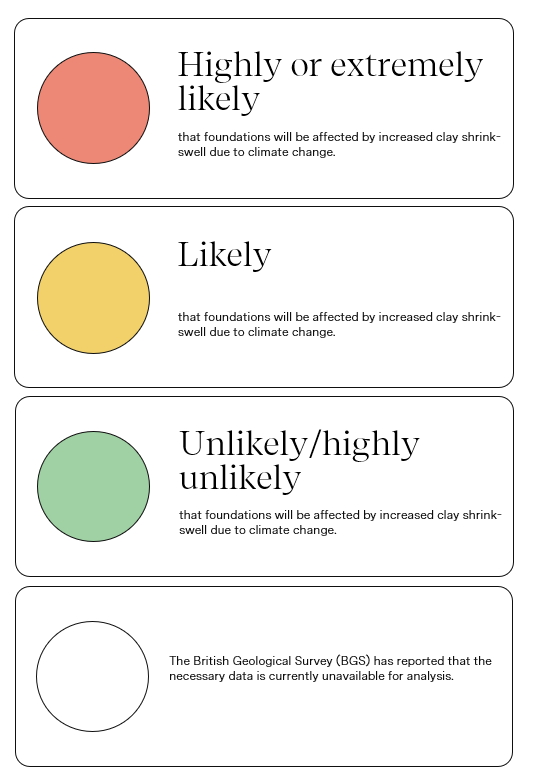These changes can have significant consequences on structures built on such soils. Swelling pressures exerted by expansive soils can cause heave or lifting of structures. Conversely, shrinkage can cause settlement or subsidence and both types of movement may occur differentially across a site. This differential movement can lead to uneven distribution of loads, potentially compromising the stability and integrity of buildings and infrastructure.
Shrink swell is one of the costliest and most globally widespread geological hazards, presenting significant geotechnical and structural challenges to construction and property development, and costing the UK over £400 million annually. The increased frequency and intensity of extreme weather events, a consequence of climate change, have profound implications for expansive soils. Rising temperatures, altered precipitation patterns, and prolonged droughts directly affect the moisture levels within these soils. Consequently, this amplifies the potential for shrink swell, exacerbating geotechnical and structural challenges for properties built on or near such soils. The foundations of properties that have been previously unaffected could therefore become susceptible due to the increased variation in moisture contents. Buildings constructed on expansive soils may be susceptible to foundation movement, which can result in several problems including cracked walls, uneven floors, and damaged infrastructure, including plumbing systems. These issues not only put the property’s stability and safety in jeopardy, but also diminish its overall value and market appeal. The damage caused by shrink swell can result in substantial repair costs and may even lead to insurance claims due to subsidence.
Therefore, accurate prediction and mapping of ground with the potential to shrink or swell is essential for comprehensive conveyancing reports. It is important to note that climate change data is a prediction or projection and cannot provide certainty. However, by considering the possibilities and incorporating predictive techniques, property buyers, sellers, and lenders can make informed decisions. Climate estimates for shrink swell mapping give crucial data for property valuation, risk mitigation, and the implementation of appropriate engineering interventions.
To facilitate accurate predictions, the British Geological Survey has developed GeoClimateUKCP18 Premium, a state-of-the-art data model on ground movement and subsidence due to climate change for Great Britain. This model combines BGS GeoSure, the UKCP18 Representative Concentration Pathway (RCP) 8.5 climate projections, ZOODRM groundwater recharge model and expert knowledge on the behaviour of geological formations. The results, which include two temporal datasets with 11-year time intervals, 2030 (2025 to 2035) and 2070 (2065 to 2075), identify a GB-wide distribution for increased susceptibility to clay shrinkage, related to subsidence, for the 21st century. For each period, three layers are provided: Average (50th percentile of days above threshold), Wetter (10th percentile of days above threshold), and drier (90th percentile of days above threshold). Within each layer, the likelihood values range from extremely likely to highly unlikely, providing a clear visualisation of the potential impact on foundations in different regions and periods. This spatial division allows conveyancers and property buyers to easily identify and understand the level of risk associated with increased clay shrink-swell in specific areas.
This advanced dataset supplies future clay shrink swell hazard susceptibility, offering comprehensive climate change predictions. The inclusion of GeoClimateUKCP18 Premium predictions in conveyancing reports brings several significant benefits.
Firstly, it enables correct Risk Assessment by providing more precise evaluation of the risks associated with shrink swell. This allows property buyers, sellers, and lenders to make informed decisions based on comprehensive and up-to-date climate change predictions, reducing the likelihood of unexpected costs or structural issues.
Secondly, the incorporation of GeoClimate UKCP18 Premium predictions serves as a foundation for implementing proactive mitigation strategies. Property owners can act appropriately to minimise the risks posed by shrink swell by incorporating engineering solutions, foundation designs, and moisture control strategies during construction or property renovations.
Lastly, GeoClimate UKCP18 Premium equips property buyers and investors with valuable insights into the long-term viability and resilience of properties. With climate change becoming increasingly prevalent, it is essential to future proof investments by considering the potential shrink swell related issues and making informed decisions based on reliable data.
To comprehend and draw inferences from the raw data, could take some time. We at Martello understand the need for simple, quick, and straightforward data interpretation. Therefore, we have implemented the following traffic light technique to convey this data in a way that will help customers quickly grasp the risk associated with any given property.

This information can be found in the subsidence section of the climate change report. Each period will be assigned its own risk level. Martello have not manipulated the data in any way, and all data is as provided by BGS.
For more information contact us. Prepare for climate change impacts in your property transactions with Martello’s comprehensive conveyancing reports.




















